Sure, kids are back in school, the days have grown shorter, and in some places there's a definte bite in the air. But that doesn't mean you should ignore visiting a national park park.
Here are 10 (or more) reasons to help you head to the parks in the months to come.
1. General George Washington and his Continentals spent a very, very cold winter in Valley Forge back in 1777-78. You don't have to camp out in a snow storm to empathize with them, but a winter day's trip to Valley Forge National Historical Park gives you a chance to walk the landscape, peer into replicas of the cabins the troops slept in, and gain at least a small sense of the hardships they endured. On December 19, the park will offer its annual commemoration of the Continental Army's march into Valley Forge.
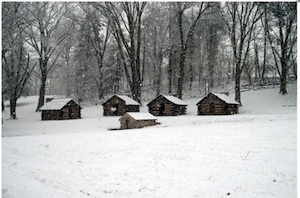
Visit Valley Forge and see how the Colonials wintered. NPS photo.
During the event, re-enactors will lead visitors on 20-minute, quarter-mile, candlelit walks from the Park's Theatre (adjacent to the Visitor Center) to the Muhlenberg Brigade area. Muhlenberg will be patrolled by Washington's Guards and occupied by soldiers and camp followers who'll tell attendees about hut construction and daily life at Valley Forge. Visitors may also "report for duty" at the regiment's headquarters and warm up around the campfire listening to soldiers' tales.
2. You won't see a 100-degree day in Death Valley National Park during the winter months. Not even close. The average daily high in the park in December and January is 65 degrees, and just 72 degrees in February. In other words, perfect temps for hiking into the Mesquite Flat Sand Dunes, through the Gower Gulch Loop, or into Natural Bridge Canyon.
Winter is a great time to roam the Death Valley sand dunes near Stovepipe Wells. These mountains of sand were created by erosion of the mountains that rim the valley floor. Walking them takes you into a giant sandbox, one complete with pockets of vegetation and intriguing displays of the park's fractured geology. Too, the dunes can hold traces of what slithered or scampered here and there before you. Time your visit to coincide with the full moon -- December 28 -- and head out ito the dunes with the moon lighting your way! Just be sure to wear warm clothing.
Joshua Tree National Park also is a great winter destination. It's not as hot as in summer -- daily highs in winter are in the 60s, though it can drop to freezing once the sun goes down -- and the climbing remains outstanding.
3. With a colder-than-usual December currently being forecast for the West, toss in some moisture and we'll have great opportunities for snowshoeing at Bryce Canyon, Cedar Breaks, Sequoia, and Great Basin national parks, just to name three. Cross-country skiing could be good, as well. Other parks to consider include Rocky Mountain (watch for a separate post on winter in this park), Voyageurs and, of course, Yellowstone and Glacier.
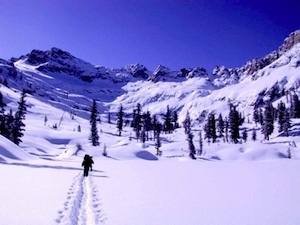
Consider a cross-country ski trip to Sequoia National Park. NPS photo.
At Sequoia, beginning cross-country skiers can gain their balance on the Crescent Meadow Road (2.5 miles one way) from the Giant Forest Museum to Crescent Meadow, or the Old Lodgepole Road (also 2.5 miles one way) from Lodgepole to the General Sherman Tree. Intermediates can tackle the Clover Creek route (2.1 miles) beteen Wuksachi and Twin Lakes or the Wolverton Trail (0.7 miles one way) from Wolverton Winder use area to the Old Lodgepole Road. Advanced skiers can choose from the Alta Trail (6.2 miles one way) from Wolverton to the Giant Forest Museum, or the Pear Lake Trail (6 miles one way) from Wolverton to the Pear Lake Ski Hut.
Glacier can be another great winter destination. Though the Going-to-the-Sun Road is not plowed across its 50 miles, it is kept open to Lake McDonald Lodge on the park's west side, and many use that access for great snowshoeing and cross-country skiing in the park with no crowds at all.
4. Not everyone enjoys cold, snowy weather. That's why there are parks such as Virgin Islands, Biscayne and Dry Tortugas for snorkeling during the winter months, like Everglades and Big Cypress for birding, and Hawaii Volcanoes and Haleakala for all of the above. If you make it to Virgin Islands NP, check out Trunk Bay. True, it's the best-known of the national park's beaches, and arguably the most-crowded, but how can you travel all the way to St. John without visiting its sugar sand beaches and warm waters with their colorful fish?
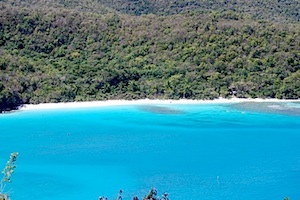
Explore Trunk Bay at Virgin Islands National Park. Kurt Repanshek photo.
In the warm waters of the cove there's an underwater snorkeling trail of sorts that makes it easy for you to identify some of the corals and fishes to be found in the park's waters. To avoid the crowds, arrive early (before 9-ish) or late (after 4). The light is great both times of the day, and you'll be able to enjoy a little more elbow room, whether you're simply sitting on the beach with a book or trying to navigate the underwater trail.
5. Olympic National Park is a great place to watch winter storms crash into the coastline. When those big waves smack into the sea stacks along Rialto Beach, the energy is explosive.
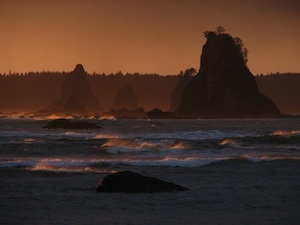
Watch storms crash massive waves into the sea stacks at Olympic National Park in winter. NPS photo.
Kalaloch Lodge overlooking the Pacific is a great basecamp. From the lodge you can walk the beaches to see what winter storms have tossed ashore or marvel at the sea stacks further up the coast. Head up to Hurricane Ridge the same day and you might find yourself in a blizzard...or with great snow conditions for skiing, snowboarding, or snowshoeing.
6. Escape the weather by going underground at Mammoth Cave or Carlsbad Caverns national parks. These two offer some of the longest cave systems in the world. And once you head below ground, the temperature is steady, there's no chance of being snowed on, and you won't slip on ice.
Make plans to visit Mammoth Cave on December 2 and you can participate in the annual Cave Sing. Enjoy the warm and touching tales from the park's cave guide and professional storyteller before embarking into the cave itself, where local musicians exhibit the cave's incomparable acoustics. End the festivities with complimentary cookies and cider at the Mammoth Cave Hotel.
7. Check out a museum. When it's cold and wet outside, escape inside at one of the great museums in the National Park System. Visit the Grand Portage National Monument Heritage Center in Minnesota to examine Ojibwe Arts and Crafts, such as snowshoes, traditional garments, headbands and more. At Boston National Historical Park, there are any number of buildings that showcase period pieces: the Paul Revere House, Old North Church, Faneuil Hall, and the Old South Meeting House, just to name a few.
8. Go for a paddle. While winter is raging across the northern half of the country, there are parks in the southern half where you can still dip a blade in January. Places such as Big Bend National Park, where you can canoe the Rio Grande, or Gulf Islands National Seashore, where the sea kayaking is spectacular. If it's not too brisk -- and there are warm days in January -- go in search of bald eagles from your canoe at Ozark National Scenic Riverways.
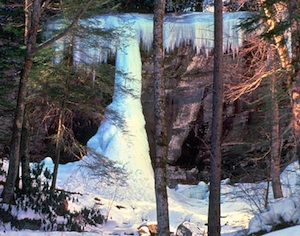
A winter's day hike in Great Smoky could reward you with a photo of a frozen Rainbow Falls. NPS photo.
9. Go fly a kite! That's right, the Wright Brothers successfully launched their glider at Kill Devil Hills in North Carolina on December 17, 1903, so why not visit the national memorial and fly your own kite. And after you've had enough, head over to Fort Raleigh National Historic Site.
10. Take a hike in your favorite park. Winter can offer an entirely different viewshed for you in the parks. Deciduous trees lose their leaves, opening up landscapes and sometimes revealing things you might never have realized were there, such as old cabins or rock walls.
Winter can also offer more solitude than you encounter in summer. As a result, your senses will be more tuned into birds and wildlife on the move. Parks that preserve Civil War battlefields -- Fredericksburg and Spotsylvania National Military Park, Gettysburg National Military Park, Antietam National Battlefield, and many others -- offer poignant moments any time of year, but walking them in winter, trying to grasp the conditions the soldiers endured, seems to drive the point home even harder.

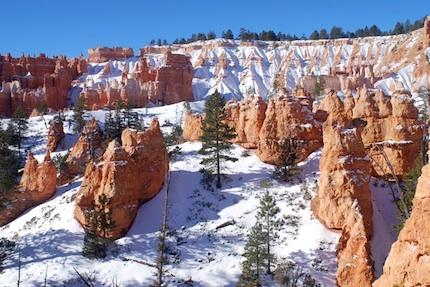
 Support Essential Coverage of Essential Places
Support Essential Coverage of Essential Places







Comments
One of my favorite places to go in the wintertime is the Carbon River entrance at Mt. Rainier. The temperate rain forest is at its best in the rainy season, and sometimes you even get snow at the entrance (at 1700 feet). It's cool, mysterious, and a wonderful place to take a walk. Just bring your boots and your goretex.
Redwood National Park in Humboldt County California is also an excellent winter destination, because it is on the coast of California and very rarely sees snow at all, or temperatures below freezing. Walk among the giants, and enjoy them without the summer tourists.
My all time fav is Yellowstone. A few times I have based out of Gardner in mid Feb and XC Skied all along the Lamar Valley area. Few crowds. Great scenery and weather but the biggest thing is the insane wildlife viewing. The animals gather in the valley because the wind blows the snow away. Bison. Bull Elk. Sheep. Wolves. I' ve had some of my coolest wildlife experiences there.
Almost two years ago, I awoke early on Christmas morning in my home in Grand Junction, Colorado. I decided at that moment to drive to Arches National Park, and arrived at the trailhead to Delicate Arch a half hour or so before dawn. Hiking to the arch, and having the trail to myself, I arrived there just before sunrise, where I was surprised to see a wedding party setting up. Although I had imagined having Delicate Arch to myself at a Christmas morning sunrise, I was perfectly okay with what I found. What a great setting for their Christmas wedding and what a beautiful day for an impromptu hike for me. I spent the next several hours exploring the park, the day warming to a perfect sunny day in the low 60s. The sunrise, the wedding party, the park trails with a minimum of fellow explorers, perfect.